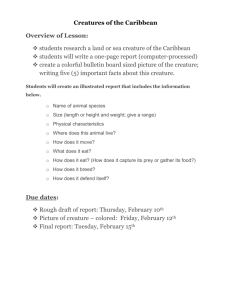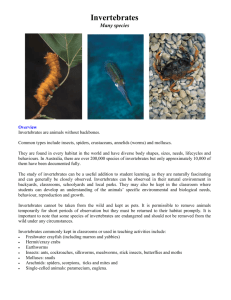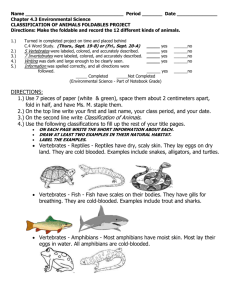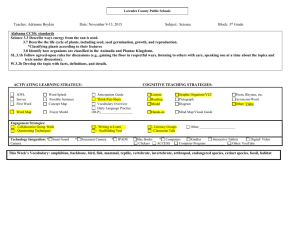Lesson Plan - KBS GK12 Project
advertisement
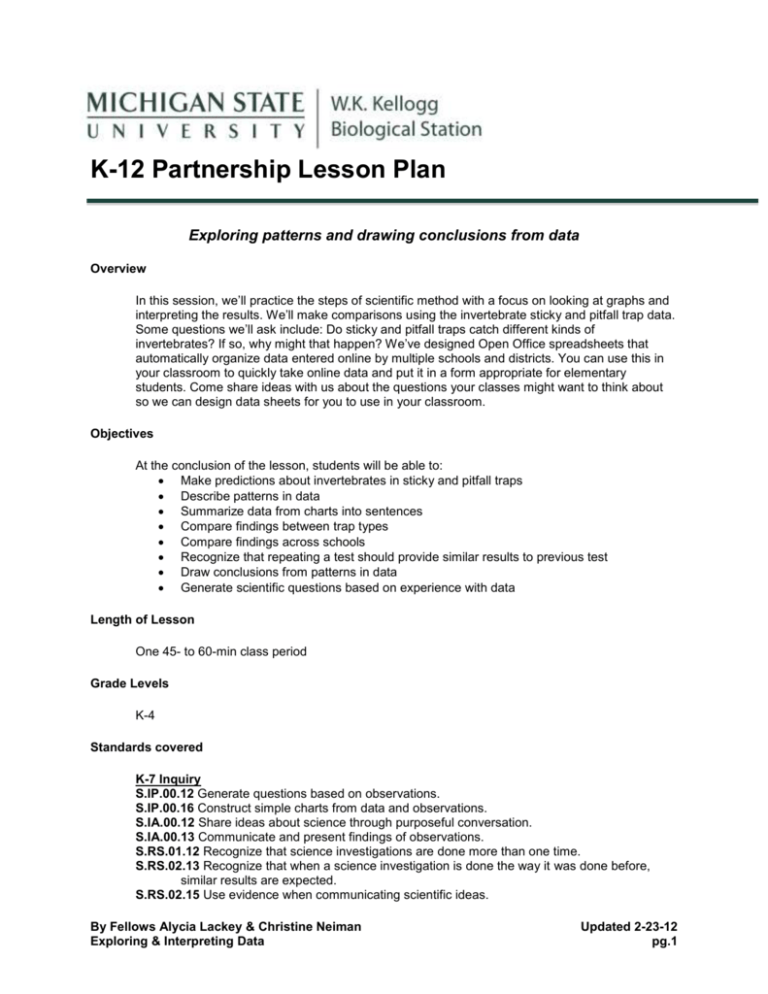
K-12 Partnership Lesson Plan Exploring patterns and drawing conclusions from data Overview In this session, we’ll practice the steps of scientific method with a focus on looking at graphs and interpreting the results. We’ll make comparisons using the invertebrate sticky and pitfall trap data. Some questions we’ll ask include: Do sticky and pitfall traps catch different kinds of invertebrates? If so, why might that happen? We’ve designed Open Office spreadsheets that automatically organize data entered online by multiple schools and districts. You can use this in your classroom to quickly take online data and put it in a form appropriate for elementary students. Come share ideas with us about the questions your classes might want to think about so we can design data sheets for you to use in your classroom. Objectives At the conclusion of the lesson, students will be able to: Make predictions about invertebrates in sticky and pitfall traps Describe patterns in data Summarize data from charts into sentences Compare findings between trap types Compare findings across schools Recognize that repeating a test should provide similar results to previous test Draw conclusions from patterns in data Generate scientific questions based on experience with data Length of Lesson One 45- to 60-min class period Grade Levels K-4 Standards covered K-7 Inquiry S.IP.00.12 Generate questions based on observations. S.IP.00.16 Construct simple charts from data and observations. S.IA.00.12 Share ideas about science through purposeful conversation. S.IA.00.13 Communicate and present findings of observations. S.RS.01.12 Recognize that science investigations are done more than one time. S.RS.02.13 Recognize that when a science investigation is done the way it was done before, similar results are expected. S.RS.02.15 Use evidence when communicating scientific ideas. By Fellows Alycia Lackey & Christine Neiman Exploring & Interpreting Data Updated 2-23-12 pg.1 S.IA.03.13 Communicate and present findings of observations and investigations. S.IA.03.15 Compare and contrast sets of data from multiple trials of a science investigation to explain reasons for differences. Content L.OL.00.11 Identify that living things have basic needs. P.PM.01.11 Demonstrate the ability to sort objects according to observable attributes such as color, shape, size, sinking or floating. L.OL.01.13 Identify the needs of animals. P.PM.02.12 Describe objects and substances according to their properties (color, size, shape, texture, hardness, liquid or solid, sinking or floating). L.OL.03.32 Identify and compare structures in animals used for controlling body temperature, support, movement, food-getting, and protection (for example: fur, wings, teeth, scales). L.OL.03.42 Classify animals on the basis of observable physical characteristics (backbone, body coverings, limbs). L.EV.03.12 Relate characteristics and functions of observable body parts to the ability of animals to live in their environment (sharp teeth, claws, color, body coverings). L.OL.04.16 Determine that animals require air, water, and a source of energy and building material for growth and repair. L.EV.04.21 Identify individual differences (color, leg length, size, wing size, leaf shape) in organisms of the same kind. L.EV.04.22 Identify how variations in physical characteristics of individual organisms give them an advantage for survival and reproduction. Materials Laptop connected to projector to show data PowerPoint Presentation Invertebrate Handout (has pictures of invertebrates from particular orders) Exploring Patterns in Data worksheet o Level 1 - Graph is provided o Level 2 - Students draw the graph Access all materials at: http://kbsgk12project.kbs.msu.edu/blog/2011/09/14/best-plots-lesson-plans/ Background Elementary students have the opportunity to interpret data and make conclusions about the long term school yard research plots. Some classes even had the opportunity to collect this data, which makes this a great continuation of their experience with the scientific method. Even students that don’t have access to research plots or haven’t collected data will benefit from this practice of the scientific method. Elementary inquiry activities often focus on making observations. Other parts of the scientific method are part of these inquiry activities, but there may be little time in the classroom to focus on interpreting data and making conclusions. In this lesson, the data is already available, so students can focus on describing and interpreting patterns. Activities of the session 1. Introduction to scientific method & data collected (use PowerPoint Presentation) a. Review the steps of the scientific process: questions, hypotheses & predictions, design experiment, collect data, interpret data, make conclusions, then develop more questions (it’s a cycle!). i. Today we’ll practice all parts of the scientific process with a focus on interpreting data and making conclusions. By Fellows Alycia Lackey & Christine Neiman Exploring & Interpreting Data Updated 2-23-12 pg.2 ii. We’ll use our experiments with the BEST plots to practice the scientific process, and we’ll focus on the invertebrate biodiversity data, comparing invertebrates caught in sticky and pitfall traps. b. Review how invertebrate trap data was collected c. How the data was collected: i. In the fall, classes placed a sticky trap and a pitfall trap in each plot (8 plots in a block). ii. They left traps out for a week to collect invertebrates. iii. They collected the traps and counted the number of invertebrates caught by order, which is a scientific way to group organisms. iv. We put these traps out because we wanted to know what kinds of invertebrates would visit our research plots. There are lots of comparisons we can make, but the comparison we’ll focus on today is between the sticky and pitfall traps. d. Review the kinds of invertebrates that were collected. (Invertebrate Handout) e. Students develop hypotheses for the following questions through discussion (Record on the board): i. How do you think the types of invertebrates could differ between the sticky and pitfall traps? Why? 1. Sticky traps are more likely to catch flying invertebrates and invertebrates that move around near the tops of plants. 2. Pitfall traps are more likely to catch invertebrates that crawl along the ground. ii. Which invertebrates [go through each one on handout] are more likely to be found in sticky traps? In pitfall traps? iii. Which traps might collect more invertebrates overall? Why might this happen? 1. Sticky traps have more surface area, smaller invertebrates might be flying iv. Why might data collected be similar between schools (different collecting sites)? Why might it be similar? v. What other questions could we ask? f. Students generate list of potential comparisons of types of invertebrates. i. In this lesson, we are prepared to address these comparisons: 1. Insect vs. Other Invertebrate 2. Wings vs. No Wings 3. Number of legs (0, 6, 8, more than 8) 2. Let’s look at the raw data. (Back to the computer to show data.) a. Here’s the data sheet b. The data from the google spreadsheets is overwhelming because each order is listed for all 8 plots separately. It would be hard to analyze this data as is! c. Scientists have to organize their data so that they can make particular comparisons. d. We’re using a data sheet that pulls data from the google spreadsheets and organizes it for us. Scientists at KBS did this work for us. e. Go through the first comparison in the Open Office spreadsheet (each invertebrate group summarized across plots and across schools). i. Describe the comparison. ii. Before looking at the data, make a prediction about what you think the pattern for this comparison will look like. iii. Look at the graph. iv. Have students describe the patterns they see. Take notes for the class to review. v. Think-pair-share: Based on these patterns, what conclusions can you make? Explain why you think this happens. vi. Do the conclusions match our predictions? Why/why not? 1. It’s okay predictions don’t match conclusions! Science is a learning process. Just reflect on what you have a better understanding of now after looking at the data.) By Fellows Alycia Lackey & Christine Neiman Exploring & Interpreting Data Updated 2-23-12 pg.3 f. Go over other comparisons in the Open Office spreadsheet in small groups (Wings/No Wings, Insects vs Other Invertebrates, # Legs). Hand out worksheet (Level 1 more guided or Level 2 less guided) that parallels the steps you just practiced as a class for different comparisons. i. Have students report out (Take notes on the board) 1. Comparison, prediction, patterns observed, conclusion with explanation, match to prediction, what they learned from looking at the data ii. Review each comparison and the findings. What do students learn from thinking about all of these comparisons together? Getting a bigger picture? iii. What other questions might students want to ask related to the invertebrate trap data? g. If you have time & would like to, you can look at the data separated by school as a class. h. Other interesting questions to discuss: i. Why don’t we find some types of invertebrates (e.g., earthworms)? 1. Earthworms might not come to the surface of the soil ii. (If the data is available) How do invertebrates collected in May compare to those collected in August? Why might some invertebrates be more common at different times of year? 1. Emergence dates? Breeding time? 3. Revisit the scientific process and how your students practiced each step with focus on looking at patterns in data and interpreting results. Science is a circular process - experiments and their results bring new questions to evaluate. Additional Resources Here are some websites that give additional activities for exploring data & making interpretations. o http://www.nsa.gov/academia/early_opportunities/math_edu_partnership/ collected_learning/elementary/data_analysis.shtml o http://www.learningtoday.com/corporate/Data-Analysis.asp o http://seeingmath.concord.org/data_predictions.html Extensions and Modifications Instead of going directly to looking at the graphs, make the graph as a class from the summary data. If your class isn’t ready to work on interpreting data in small groups, you can go through these examples as a class. Model the kinds of answers they would write if they were filling out worksheets themselves. Have students draw the types of invertebrates found in each trap type (sticky or pitfall). What characteristics are similar among invertebrates in the same trap? Different between invertebrates caught in different traps. Introduce new examples of invertebrates and ask where they would be most likely to be caught. Consider requesting a few sticky and pitfall traps from KBS to set up your own traps. Then collect the data, and follow similar data analysis, interpretation, and discussion as outlined above. You could also compare your data to that from other schools. Compare schools that differ in plant communities, landscapes (drainage, amount of concrete, rural vs urban), and soils. A KBS scientist can help you identify schools that differ in these characteristics. Assessment By Fellows Alycia Lackey & Christine Neiman Exploring & Interpreting Data Updated 2-23-12 pg.4 Use the worksheet to assess students’ understanding of making predictions, describing patterns in data, interpreting and explaining results, and comparing results to predictions. By Fellows Alycia Lackey & Christine Neiman Exploring & Interpreting Data Updated 2-23-12 pg.5


